
Remote angkor temples: hidden gems off beaten path
Tired of the crowds at Angkor Wat? Discover the allure of remote Angkor temples like Beng Mealea, Kbal Spean, and Phnom Kulen—hidden gems over 50 km from Siem Reap that offer a journey into ancient mystery. This guide reveals their historical significance, travel tips, and photography secrets for an unforgettable adventure off the beaten path.
Beng Mealea: The Jungle Temple Adventure
Beng Mealea stands as one of Angkor’s most atmospheric remote temples, located 60 km from Siem Reap. This 11th-century Hindu temple, built under King Suryavarman II, remains entangled in jungle growth, offering a hauntingly beautiful experience of decay and mystery.
Constructed in the 11th century, Beng Mealea served as a Hindu temple dedicated to Vishnu. Later Buddhist elements were added, reflecting religious evolution. The 14-hectare complex features a central sanctuary, three galleries, and a 1.2 km moat, mirroring Angkor Wat’s architectural style.
Beng Mealea’s layout mirrors Angkor Wat, with a central sanctuary surrounded by galleries and a moat. Its 180 lintels depict Hindu epics, while later Buddhist carvings add layers of spiritual history. Wooden walkways now aid exploration without compromising its wild allure.
Decades of abandonment left Beng Mealea in dramatic decay. Moss blankets crumbling stones, and roots twist through walls. Collapsed towers and scattered blocks create a labyrinthine ruin, with the 1.2 km moat emphasizing its isolated, untamed beauty.
- Explore the 14-hectare layout with a 1.2 km moat
- Spot 180 Hindu-themed lintels and Buddhist carvings
- Photograph roots merging with ruins at sunrise
- Discover the central sanctuary’s intricate details
Wooden walkways allow safe navigation through Beng Mealea’s ruins. These paths balance preservation with accessibility, letting visitors experience its wild state while protecting fragile structures from further damage.
Reaching Beng Mealea requires private transport. A tuk-tuk costs $40-60 USD round-trip, while day tours from Siem Reap include this temple with Koh Ker or floating villages. The 60 km journey takes 1-1.5 hours by road.
Beng Mealea requires a $5 USD entrance fee, separate from the Angkor Pass. Parking fees apply for private vehicles. No discounts exist for children, and tickets are cash-only, with no online purchase options.
Visit early morning to avoid heat and crowds. Dry season (November-February) offers ideal conditions, while rainy season (June-October) brings lush foliage but muddy paths. Midday visits risk high temperatures and fewer photo opportunities.
Beng Mealea gained fame in Two Brothers (2004), enhancing its cinematic mystique. The film’s production installed temporary wooden structures, later repurposed for visitor safety, blending Hollywood history with remote temple exploration.
For photography, sunrise and sunset provide soft light through jungle canopies. Capture moss-covered stones and root-entangled ruins. Use wide-angle lenses for scale and monopods for low-light stability in shaded areas.
Hiring a local guide ($10-15 USD) reveals hidden carvings and historical context. Guides explain 12th-century construction techniques, Buddhist adaptations, and the temple’s role in Angkor’s spiritual network, enriching visits beyond surface-level exploration.
Kbal Spean: The River of a Thousand Lingas
Kbal Spean, a unique Angkor site 50 km from Siem Reap, features riverbed carvings rather than traditional temple structures. This remote destination, known as the « River of a Thousand Lingas, » offers a glimpse into Angkor’s spiritual connection with natural elements and sacred waterways.
Kbal Spean’s name reflects Hindu symbolism: « lingas » represent Shiva, carved into the riverbed for purification. These sacred symbols were believed to sanctify water flowing to Angkor, connecting religious practice with the Khmer Empire’s water systems and agricultural prosperity.
Created between the 11th-12th centuries under Kings Suryavarman I and Udayadityavarman II, carvings served dual purposes. They blessed water flowing to Angkor while reinforcing Hindu cosmology through intricate depictions of divine figures like Vishnu and Shiva.
Reaching Kbal Spean requires a 1.5-hour jungle hike. The 3.4 km trail includes uneven terrain, tree roots, and rocky sections. Visitors should wear sturdy footwear and carry water, as facilities are limited. The 50 km journey from Siem Reap demands private transport for accessibility.
Along the 150-meter riverbed, visitors encounter lingas, yonis, and Hindu deity carvings. Vishnu appears with Lakshmi, Shiva with Uma, and Brahma on a lotus. These symbols transform the river into a living altar, blending artistry with spiritual function.
Ancient Khmers believed lingas blessed water flowing to Angkor’s fields. Sacred connection between carved stones and agricultural fertility underscores Kbal Spean’s role in the empire’s spiritual infrastructure, linking remote temples to broader water management systems.
- Wear moisture-wicking clothing for jungle humidity
- Carry 2L water minimum for hydration
- Use waterproof phone cases near water features
- Bring lightweight trekking poles for uneven terrain
- Secure valuables in waterproof bags during hikes
July-December offers ideal visibility as lower water levels expose carvings. Avoid April-May’s peak heat. Morning visits provide cooler temperatures and softer light for photography. Rainy season (June-October) brings lush scenery but reduced carving visibility.
Private tours from Siem Reap ($45-60 USD) offer convenient transport to Kbal Spean. Shared vans ($15-20 USD) require early booking. Combining with Banteay Srei or Phnom Kulen creates efficient 50+ km itineraries for remote temple exploration.
Pair Kbal Spean with Angkor Centre for Conservation of Biodiversity (ACCB), 40 km north of Siem Reap. This wildlife sanctuary rescues endangered species. Combined visits create full-day itineraries through northern Angkor’s remote attractions.
Basic facilities at Kbal Spean include restrooms near the trailhead and minimal food vendors. No shops exist within the site. Visitors must bring water, snacks, and personal items. Carry-out all waste to protect this sacred environment.
Photograph carvings at midday when sunlight penetrates jungle cover. Use polarizing filters to reduce water glare. Capture unique linga patterns during low water levels (July-December). Morning mist enhances jungle atmosphere in wide-angle shots.
Respect Kbal Spean’s sacred status by avoiding direct contact with carvings. Follow designated paths to preserve fragile engravings. Support conservation by visiting ACCB’s wildlife protection programs. Cultural sensitivity enhances the experience of this remote Angkor treasure.
Phnom Kulen: The Sacred Mountain Sanctuary
Phnom Kulen stands as a sacred mountain plateau located about 50 km from Siem Reap. This 487-meter-high site marks where King Jayavarman II declared Khmer Empire independence in 802 CE. Its spiritual significance draws Cambodian pilgrims and history enthusiasts to its ancient carvings and natural beauty.
King Jayavarman II proclaimed Khmer sovereignty […] Devaraja cult. The mountain became Mahendraparvata, Angkor’s first capital. This event initiated centuries of Khmer rule, linking the site to the empire’s political and religious foundations through ceremonial stone inscriptions.
Modern Phnom Kulen National Park preserves this spiritual heritage. Cambodians pilgrimage to its Hindu carvings and Preah Ang Thom’s 8m reclining Buddha. The 37,375-hectare park combines religious devotion with ecological conservation, protecting forests and water sources vital to regional ecosystems.
Preah Ang Thom’s reclining Buddha dominates Phnom Kulen’s summit. Carved in the 16th century, this colossal figure represents Buddha’s nirvana. Visitors climb 600 steps past souvenir stalls to reach the sacred site, where incense and offerings create a living religious atmosphere.
Phnom Kulen’s carvings differ by featuring open-air carvings. While both sites display Hindu lingas, Phnom Kulen’s carvings appear on dry riverbed sections. These 11th-12th century symbols focus on Shiva worship, contrasting with Kbal Spean’s submerged engravings.
Phnom Kulen’s waterfalls offer natural swimming pools surrounded by jungle. Two main cascades measure 4-20 meters high. Locals picnic here weekends. Basic changing areas exist, but visitors should bring water and shoes for slippery rocks. Water levels vary seasonally, peaking during monsoon months.
Archaeologists uncovered 40 brick temples, ancient dams, and 9th-13th century hydraulic systems. A 550m ceremonial staircase discovered in 2017 reveals complex infrastructure. LiDAR mapping shows temple networks and prehistoric cave sites, demonstrating continuous occupation from prehistoric times through the Khmer Empire.
| Category | Information | Practical Tip |
|---|---|---|
| Location & Access | 50km north of Siem Reap (1-2 hour drive). Dirt road conditions from Banteay Srei (18km away). | Private vehicle/tour recommended due to uneven roads. Budget $40-60 USD for round-trip tuk-tuk. |
| Kbal Spean Site | 40-minute jungle hike required. Access restricted until 15:30 daily. Dry season (Jan-Jun) = limited carvings visibility. | Visit July-Dec for optimal water levels. Wear sturdy shoes for rocky terrain. |
| Facilities | Limited dining at trail entrance. Basic restrooms available. No shops inside park. | Bring water/snacks. Carry out all waste to protect the environment. |
| Key Attractions | Reclining Buddha (10m sandstone). River of a Thousand Lingas (distinct from Kbal Spean). Seasonal waterfalls for swimming. | Combine with Banteay Srei visit (nearby temple). |
| Entrance Fees | $20 USD park fee (2023). Separate from Angkor Pass. Cash payments only. | Purchase tickets at main entrance checkpoint. |
Photograph Phnom Kulen’s carvings early morning when light hits riverbed engravings. Capture Preah Ang Thom’s scale with wide-angle lenses. For waterfalls, use neutral density filters to blur water motion. Sunrises at the reclining Buddha offer dramatic lighting through jungle canopies.
Visitors should avoid touching carvings and stay on marked paths. Respect local pilgrims’ practices at sacred sites. Refrain from removing natural objects or leaving offerings. Supporting ACCB’s conservation efforts aligns with the park’s dual mission of cultural preservation and environmental protection of this 37,375-hectare sanctuary.
These remote Angkor temples—Beng Mealea’s jungle-clad ruins, Kbal Spean’s sacred river carvings, and Phnom Kulen’s spiritual summit—invite travelers to uncover Cambodia’s untamed beauty beyond crowded circuits. Prioritize a morning visit during dry seasons, pack sturdy shoes and water, and embrace guided tours to unlock hidden stories. For those craving unfiltered history and serene landscapes, these off-the-beaten-path wonders promise journeys where discovery feels timeless.
FAQs About the Tours
Any question ?
Are there specific dress codes ?
Yes, there is a strict dress code for visiting the Angkor temples. Both men and women must have their shoulders covered, and skirts, dresses, pants, or shorts must cover the knees. Failure to comply with this dress code may result in denied access to the sites.
This code of conduct was implemented following incidents with tourists. To ensure a quality visit, only qualified Cambodian guides licensed by the Ministry of Tourism are allowed to guide you at Angkor.
Are there dangers (animals, insects) to watch out for in the remote Angkor temples ?
Yes, there are dangers related to animals to be aware of when visiting the Angkor temples. Aggressive macaques are present at Angkor Wat. These monkeys, accustomed to being fed by humans, have developed aggressive behavior towards tourists. They may bite, steal food, and damage temples by climbing and dislodging stones.
It’s generally recommended to protect yourself against mosquito bites, which can transmit diseases like dengue or malaria. Although not specifically mentioned in the source, Cambodia is home to several potentially dangerous species, including venomous snakes.
03
Can you camp near these temples ?
It is possible to camp near the Angkor temples, but there are several elements to consider. Camping and chalet-style accommodations are available in Siem Reap, the city near the Angkor temples. These options can serve as a base for exploring the remote temples.
However, it is important to inquire about the regulations regarding wild camping in Cambodia. Wild camping is generally discouraged. It is best to seek permission from local landowners before setting up camp on their land. Also, be aware of landmines in rural areas and near some temples.
Expert Team
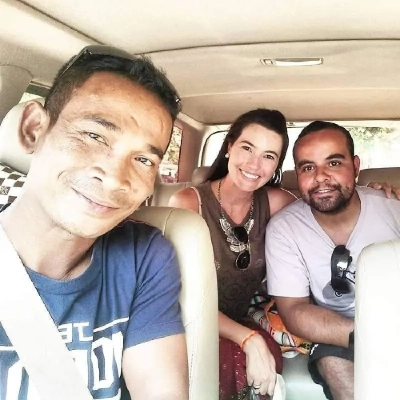
Kim Hak
MiniVan Driver
Hello Dear Valued Visitor !
My name is Kim Hak, and I’m a local Cambodian driver specializing in tourist services in Siem Reap, Cambodia. I drive a Grand Starex and offer taxi services and tours to all 25 provinces and cities (24-hour service available).
I am an experienced driver who has been driving since 2006, and I can speak English and Mandarin.
I love providing recommendations for interesting places in Siem Reap and showing my customers the best parts of Cambodia. I will ensure that my customers are well taken care of, safe, and have the best travel experience while visiting Siem Reap, Cambodia.
I look forward to showing you around Siem Reap, Cambodia! =)
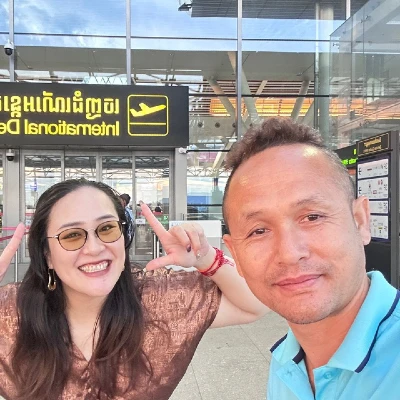
Sophara
Car Driver
Greetings, travelers! I’m Sophara, your friendly local guide and driver based in Siem Reap, Cambodia. With my comfortable SUV and Grand Starex vehicles, I’m ready to take you on unforgettable journeys throughout Cambodia’s 25 provinces and cities, any time of day or night.
Since 2008, I’ve been passionate about sharing the wonders of my beautiful country with visitors from around the world. Speaking both English and Mandarin, I bridge cultures while creating meaningful travel experiences.
I specialize in creating customized adventures that reveal both Cambodia’s famous landmarks and its best-kept secrets.. Your safety, comfort, and satisfaction are always my top priorities.
Ready to explore Cambodia with a local who truly cares about making your trip extraordinary? Let’s create amazing memories together!
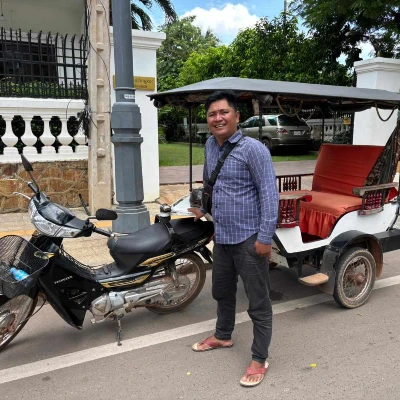
Mister Ra
Tuk-Tuk Driver
Hello there ! I’m Mister Ra, your local tuk-tuk driver and guide in Siem Reap, Cambodia. With my reliable tuk-tuk, I specialize in exploring the magnificent Angkor Wat temple complex and providing comprehensive city tours around Siem Reap.
For nearly two decades, I’ve been showing visitors the incredible temples of Angkor and the vibrant streets of our beautiful city. Speaking English fluently, I enjoy sharing stories and connecting with travelers from all corners of the world
Ready to explore Siem Reap’s treasures with a local who’s passionate about sharing his hometown? Let’s create some amazing memories together !
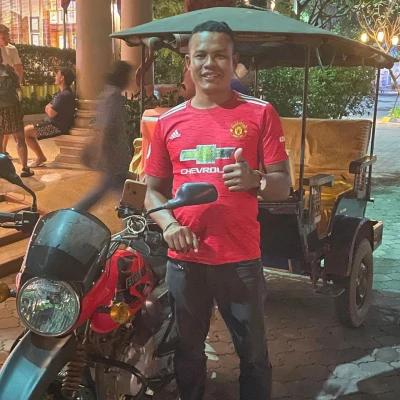
Chom
Tuk-Tuk Driver
Greetings, fellow travelers !
I’m Chom, your friendlyTuk-Tuk Driver here in Siem Reap, Cambodia.
With my reliable Tk-Tuk, I’ve been serving visitors since 2016, offering transportation and tours throughout Angkor Wat and beyond
Your comfort, security, and satisfaction are my personal mission. Every trip is designed to exceed expectations while respecting your time and budget.
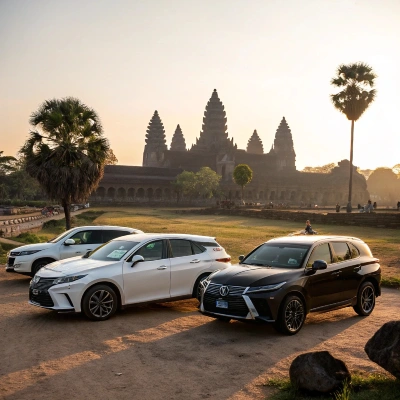
More CARS, More TUKTUK
if needed
Don’t worry we will have many other solutions when we will be fully-booked
We have many friends or relatives to call when needed
Only professional people of course